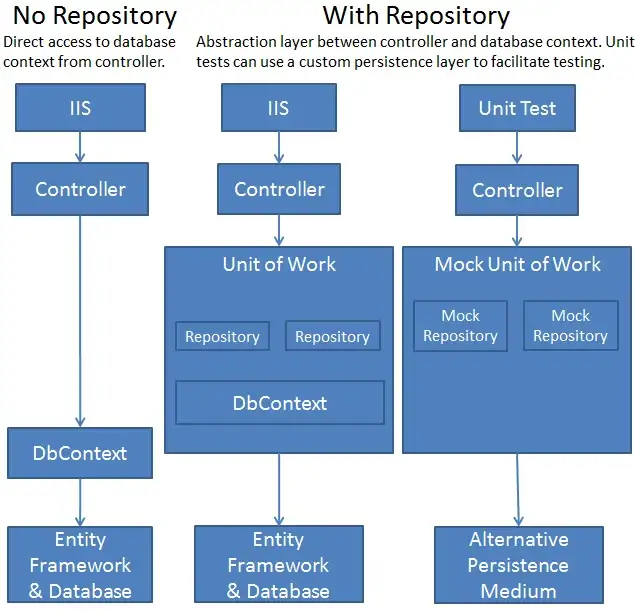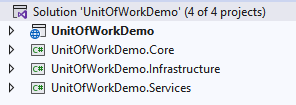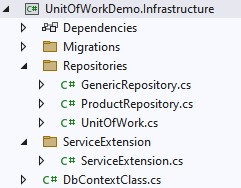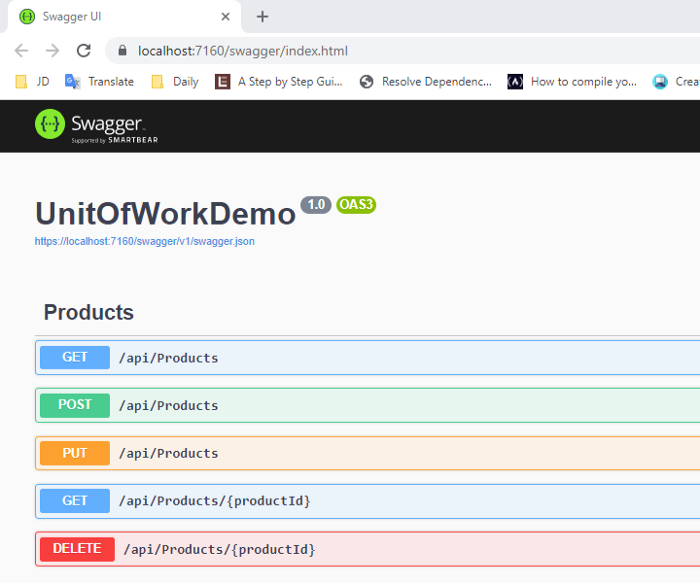Unit of Work With Generic Repository Implementation Using .NET Core 6 Web API
This article reviews the Unit of Work design pattern using a generic repository and a step-by-step implementation using the.NET Core 6 Web API.
Join the DZone community and get the full member experience.
Join For FreeWe will go over the Unit of Work design pattern using a generic repository and a step-by-step implementation using the.NET Core 6 Web API.
Prerequisites
- Visual Studio 2022
- SQL Server
- .NET Core 6 SDK
Repository Pattern
- The repository pattern is used to create an abstraction layer between the data access layer and the business layer of an application.
- This pattern helps to reduce code duplication and follows the DRY principle.
- It also helps to create loose coupling between multiple components; when we want to change something inside the data access layer, that time does not need to change another layer where we consume that functionality.
- Separation of concern makes things easier to maintain the code.
- Implementing repository patterns helps us write unit test cases efficiently and easily.
Unit of Work
- Repository pattern helps us create an abstraction, decouple the code, and avoid redundant code.

Figure: The diagram is from Microsoft technical documentation.
- But sometimes, it could partially update data because when the application is huge, repositories share the same database context throughout the application and perform operations like insert, update and read. So, in that case, there might be a chance of failing some transactions, and few are executed successfully due to concurrency issues. So, for this reason, we use a unit of work to maintain the data integrity inside the application.
- Also, the unit of work manages an in-memory database when we perform CRUD operations on some entity classes as one transaction. If there are some database operations that will fail, then that case all operations will roll back.
- It also helps to make layers loosely coupled using dependency injection and follow Test Driven Development (TDD) principles.
Step-By-Step Implementation
Step 1
Create a new .NET Core Web API.

Step 2
Configure your application.

Step 3
Provide some additional details.

Project Structure.

Step 4
Create three class library projects inside the main solution.

Step 5
Next, add one model class inside the UnitOfWorkDemo.Core project and also add some interfaces.

ProductDetails.cs
namespace UnitOfWorkDemo.Core.Models
{
public class ProductDetails
{
public int Id { get; set; }
public string ProductName { get; set; }
public string ProductDescription { get; set; }
public int ProductPrice { get; set; }
public int ProductStock { get; set; }
}
}IGenericRepository.cs
using System;
using System.Collections.Generic;
using System.Linq;
using System.Text;
using System.Threading.Tasks;
namespace UnitOfWorkDemo.Core.Interfaces
{
public interface IGenericRepository<T> where T : class
{
Task<T> GetById(int id);
Task<IEnumerable<T>> GetAll();
Task Add(T entity);
void Delete(T entity);
void Update(T entity);
}
}IProductRepository.cs
using UnitOfWorkDemo.Core.Models;
namespace UnitOfWorkDemo.Core.Interfaces
{
public interface IProductRepository : IGenericRepository<ProductDetails>
{
}
}IUnitOfWork.cs
namespace UnitOfWorkDemo.Core.Interfaces
{
public interface IUnitOfWork : IDisposable
{
IProductRepository Products { get; }
int Save();
}
}Step 6
Now, we are going to add an implementation of all repositories that we created earlier and also create one DbContextClass inside that.

Project File
<Project Sdk="Microsoft.NET.Sdk">
<PropertyGroup>
<TargetFramework>net6.0</TargetFramework>
<ImplicitUsings>enable</ImplicitUsings>
<Nullable>enable</Nullable>
</PropertyGroup>
<ItemGroup>
<ProjectReference Include="..\UnitOfWorkDemo.Core\UnitOfWorkDemo.Core.csproj" />
<PackageReference Include="Microsoft.EntityFrameworkCore" Version="6.0.8" />
<PackageReference Include="Microsoft.EntityFrameworkCore.SqlServer" Version="6.0.8" />
<PackageReference Include="Microsoft.EntityFrameworkCore.Tools" Version="6.0.8" />
</ItemGroup>
</Project>GenericRepository.cs
using Microsoft.EntityFrameworkCore;
using System;
using System.Collections.Generic;
using System.Linq;
using System.Text;
using System.Threading.Tasks;
using UnitOfWorkDemo.Core.Interfaces;
namespace UnitOfWorkDemo.Infrastructure.Repositories
{
public abstract class GenericRepository<T> : IGenericRepository<T> where T : class
{
protected readonly DbContextClass _dbContext;
protected GenericRepository(DbContextClass context)
{
_dbContext = context;
}
public async Task<T> GetById(int id)
{
return await _dbContext.Set<T>().FindAsync(id);
}
public async Task<IEnumerable<T>> GetAll()
{
return await _dbContext.Set<T>().ToListAsync();
}
public async Task Add(T entity)
{
await _dbContext.Set<T>().AddAsync(entity);
}
public void Delete(T entity)
{
_dbContext.Set<T>().Remove(entity);
}
public void Update(T entity)
{
_dbContext.Set<T>().Update(entity);
}
}
}ProductRepository.cs
using UnitOfWorkDemo.Core.Interfaces;
using UnitOfWorkDemo.Core.Models;
namespace UnitOfWorkDemo.Infrastructure.Repositories
{
public class ProductRepository : GenericRepository<ProductDetails>, IProductRepository
{
public ProductRepository(DbContextClass dbContext) : base(dbContext)
{
}
}
}UnitOfWork.cs
using System;
using System.Collections.Generic;
using System.Linq;
using System.Text;
using System.Threading.Tasks;
using UnitOfWorkDemo.Core.Interfaces;
namespace UnitOfWorkDemo.Infrastructure.Repositories
{
public class UnitOfWork : IUnitOfWork
{
private readonly DbContextClass _dbContext;
public IProductRepository Products { get; }
public UnitOfWork(DbContextClass dbContext,
IProductRepository productRepository)
{
_dbContext = dbContext;
Products = productRepository;
}
public int Save()
{
return _dbContext.SaveChanges();
}
public void Dispose()
{
Dispose(true);
GC.SuppressFinalize(this);
}
protected virtual void Dispose(bool disposing)
{
if (disposing)
{
_dbContext.Dispose();
}
}
}
}DbContextClass.cs
using Microsoft.EntityFrameworkCore;
using Microsoft.Extensions.Configuration;
using System;
using System.Collections.Generic;
using System.Linq;
using System.Text;
using System.Threading.Tasks;
using UnitOfWorkDemo.Core.Models;
namespace UnitOfWorkDemo.Infrastructure
{
public class DbContextClass : DbContext
{
public DbContextClass(DbContextOptions<DbContextClass> contextOptions) : base(contextOptions)
{
}
public DbSet<ProductDetails> Products { get; set; }
}
}After that, create one extension class for which we are used to registering DI services and configure that inside the Program.cs file inside the root project.
ServiceExtension.cs
using Microsoft.EntityFrameworkCore;
using Microsoft.Extensions.Configuration;
using Microsoft.Extensions.DependencyInjection;
using System;
using System.Collections.Generic;
using System.Linq;
using System.Text;
using System.Threading.Tasks;
using UnitOfWorkDemo.Core.Interfaces;
using UnitOfWorkDemo.Infrastructure.Repositories;
namespace UnitOfWorkDemo.Infrastructure.ServiceExtension
{
public static class ServiceExtension
{
public static IServiceCollection AddDIServices(this IServiceCollection services, IConfiguration configuration)
{
services.AddDbContext<DbContextClass>(options =>
{
options.UseSqlServer(configuration.GetConnectionString("DefaultConnection"));
});
services.AddScoped<IUnitOfWork, UnitOfWork>();
services.AddScoped<IProductRepository, ProductRepository>();
return services;
}
}
}Next, add migration and update the database inside the infrastructure project using the following command.
add-migration “v1”
update-databaseStep 5
Next, create a product service inside the Services project, which we inject and consume inside the main controller.

IProductService.cs
using System;
using System.Collections.Generic;
using System.Linq;
using System.Text;
using System.Threading.Tasks;
using UnitOfWorkDemo.Core.Models;
namespace UnitOfWorkDemo.Services.Interfaces
{
public interface IProductService
{
Task<bool> CreateProduct(ProductDetails productDetails);
Task<IEnumerable<ProductDetails>> GetAllProducts();
Task<ProductDetails> GetProductById(int productId);
Task<bool> UpdateProduct(ProductDetails productDetails);
Task<bool> DeleteProduct(int productId);
}
}ProductService.cs
using System;
using System.Collections.Generic;
using System.Linq;
using System.Text;
using System.Threading.Tasks;
using UnitOfWorkDemo.Core.Interfaces;
using UnitOfWorkDemo.Core.Models;
using UnitOfWorkDemo.Services.Interfaces;
namespace UnitOfWorkDemo.Services
{
public class ProductService : IProductService
{
public IUnitOfWork _unitOfWork;
public ProductService(IUnitOfWork unitOfWork)
{
_unitOfWork = unitOfWork;
}
public async Task<bool> CreateProduct(ProductDetails productDetails)
{
if (productDetails != null)
{
await _unitOfWork.Products.Add(productDetails);
var result = _unitOfWork.Save();
if (result > 0)
return true;
else
return false;
}
return false;
}
public async Task<bool> DeleteProduct(int productId)
{
if (productId > 0)
{
var productDetails = await _unitOfWork.Products.GetById(productId);
if (productDetails != null)
{
_unitOfWork.Products.Delete(productDetails);
var result = _unitOfWork.Save();
if (result > 0)
return true;
else
return false;
}
}
return false;
}
public async Task<IEnumerable<ProductDetails>> GetAllProducts()
{
var productDetailsList = await _unitOfWork.Products.GetAll();
return productDetailsList;
}
public async Task<ProductDetails> GetProductById(int productId)
{
if (productId > 0)
{
var productDetails = await _unitOfWork.Products.GetById(productId);
if (productDetails != null)
{
return productDetails;
}
}
return null;
}
public async Task<bool> UpdateProduct(ProductDetails productDetails)
{
if (productDetails != null)
{
var product = await _unitOfWork.Products.GetById(productDetails.Id);
if(product != null)
{
product.ProductName= productDetails.ProductName;
product.ProductDescription= productDetails.ProductDescription;
product.ProductPrice= productDetails.ProductPrice;
product.ProductStock= productDetails.ProductStock;
_unitOfWork.Products.Update(product);
var result = _unitOfWork.Save();
if (result > 0)
return true;
else
return false;
}
}
return false;
}
}
}Step 6
Now, we create a Products Controller inside the main project and add multiple endpoints.
ProductsController.cs
using Microsoft.AspNetCore.Mvc;
using UnitOfWorkDemo.Core.Models;
using UnitOfWorkDemo.Services.Interfaces;
namespace UnitOfWorkDemo.Controllers
{
[Route("api/[controller]")]
[ApiController]
public class ProductsController : ControllerBase
{
public readonly IProductService _productService;
public ProductsController(IProductService productService)
{
_productService = productService;
}
/// <summary>
/// Get the list of product
/// </summary>
/// <returns></returns>
[HttpGet]
public async Task<IActionResult> GetProductList()
{
var productDetailsList = await _productService.GetAllProducts();
if(productDetailsList == null)
{
return NotFound();
}
return Ok(productDetailsList);
}
/// <summary>
/// Get product by id
/// </summary>
/// <param name="productId"></param>
/// <returns></returns>
[HttpGet("{productId}")]
public async Task<IActionResult> GetProductById(int productId)
{
var productDetails = await _productService.GetProductById(productId);
if (productDetails != null)
{
return Ok(productDetails);
}
else
{
return BadRequest();
}
}
/// <summary>
/// Add a new product
/// </summary>
/// <param name="productDetails"></param>
/// <returns></returns>
[HttpPost]
public async Task<IActionResult> CreateProduct(ProductDetails productDetails)
{
var isProductCreated = await _productService.CreateProduct(productDetails);
if (isProductCreated)
{
return Ok(isProductCreated);
}
else
{
return BadRequest();
}
}
/// <summary>
/// Update the product
/// </summary>
/// <param name="productDetails"></param>
/// <returns></returns>
[HttpPut]
public async Task<IActionResult> UpdateProduct(ProductDetails productDetails)
{
if (productDetails != null)
{
var isProductCreated = await _productService.UpdateProduct(productDetails);
if (isProductCreated)
{
return Ok(isProductCreated);
}
return BadRequest();
}
else
{
return BadRequest();
}
}
/// <summary>
/// Delete product by id
/// </summary>
/// <param name="productId"></param>
/// <returns></returns>
[HttpDelete("{productId}")]
public async Task<IActionResult> DeleteProduct(int productId)
{
var isProductCreated = await _productService.DeleteProduct(productId);
if (isProductCreated)
{
return Ok(isProductCreated);
}
else
{
return BadRequest();
}
}
}
}Also, add a database connection string inside the appsetting.json file.
{
"Logging": {
"LogLevel": {
"Default": "Information",
"Microsoft.AspNetCore": "Warning"
}
},
"ConnectionStrings": {
"DefaultConnection": "Data Source=DESKTOP;Initial Catalog=UnitOfWorkDemoDB;User Id=sa;Password=database;"
}
}After that, register for some services inside the Program class.
using UnitOfWorkDemo.Infrastructure.ServiceExtension;
using UnitOfWorkDemo.Services;
using UnitOfWorkDemo.Services.Interfaces;
var builder = WebApplication.CreateBuilder(args);
// Add services to the container.
builder.Services.AddDIServices(builder.Configuration);
builder.Services.AddScoped<IProductService, ProductService>();
builder.Services.AddControllers();
// Learn more about configuring Swagger/OpenAPI at https://aka.ms/aspnetcore/swashbuckle
builder.Services.AddEndpointsApiExplorer();
builder.Services.AddSwaggerGen();
var app = builder.Build();
// Configure the HTTP request pipeline.
if (app.Environment.IsDevelopment())
{
app.UseSwagger();
app.UseSwaggerUI();
}
app.UseHttpsRedirection();
app.UseAuthorization();
app.MapControllers();
app.Run();Finally, run the project.

Conclusion
Here we discussed repository patterns and units of work. Also included are the benefits and step-by-step implementation instructions for using the.NET Core Web API.
Happy Coding!
Published at DZone with permission of Jaydeep Patil. See the original article here.
Opinions expressed by DZone contributors are their own.

Comments